The use of stem cells in the development of organ tissue engineering continues to develop and become a trend in the medical world. Periodontal regeneration, a treatment of periodontal abnormalities aimed to restore periodontal hard and soft tissue, is currently one of the promising treatment goals. Development of stem cells in periodontal field is commonly found because when damage occurred in the periodontal tissue, its ability to regenerate is very limited.
Many studies with biological approaches showed successful regeneration in various tissues and body organs and they can be prospective alternative to periodontal treatment. The technology is known as tissue engineering involving morphogenesis of new tissue with cell compatibility and molecular biology to repair and regenerate periodontium.
Stem Cells in the Field of Dentistry
The development of stem cells in the field of dentistry is progressing rapidly. Many researches are conducted to deal with various abnormalities in the field of dentistry. Stem cells have the ability to renew themselves, and they can differentiate into multipotent from ex vivo culture with plasticity while the potential of stem cells can be divided into totipotent, pluripotent, multipotent and oligopotent / monopotent.
Current developments showed dental stem cells have shown great potential to improve periodontal tissue. Adult stem cells are currently being developed from dental stem cells. The teeth contain various types of stem cells which are divided into two groups, the first group consisting of Dental Pulp Stem Cells (DPSCs): stem cells from human exfoliated deciduous teeth (SHED), and adult dental pulp stem cells (ADPSCs). The second group is stem cells from the dental follicles (DFSCs) and periodontal ligament stem cells (PDLSCs) and Human gingival-derived mesenchymal stem cells (GMSC).
Many studies have been conducted to produce mesenchymal stem cells with osteogenic potential. However, there is still little development for application in treatment, so it needs to be improved in clinical activities. The use of scaffold combined with stem cells needs to be developed considering the ability of stem cells in the development of tissue engineering.
Furthermore, compared to MSCs derived from several other adult dental tissues such as DPSCs and PDLSCs, GMSCs reveal the same profile as cell surface molecules, with high proliferation rates, and increased population multiplication. It can be easily expanded to ex vivo for several cell-based clinical applications. This finding has provided evidence that human gingiva is easily accessed from the oral cavity or tissue samples removed due to several dental procedures, and could also function as a unique source of postnatal stem cells with potential therapeutic functions in tissue regeneration and repair.
Dental pulp which is widely used as a source of stem cells has been widely developed. Research conducted by Nam et al (2017) stated that DPSCs are a potential source of stem cells and have the same characteristics as MSCs. The study showed that DPSCs have high potential for angiogenesis and are needed in the repair of organs with vascular damage.
The research carried out by stem cell Faculty of Dental Medicine UNAIR team used a graph with SHED applied to mice experiment. The study showed significant bone growth markers such as BMP2, ALP, TGF-β1 and Osteopntin. So it is very promising for development of bone. The use of graphs with SHED in periodontitis patients experiencing bone damage and evaluated through CBCT showed that bone growth was quite good.
The field of dentistry is a source of materials can be used in all fields of medicine. The development of stem cell research at Faculty of Dental Medicine, Universitas Airlangga has developed rapidly and needs to be followed up for its application in patients who need treatment in the periodontal and other fields.
Author: Prof. Dr. Chiquita Prahasanti., drg Sp Perio (K)
Details of this research available at
http://ijms.sums.ac.ir/article_44962.html
Chiquita Prahasanti1, DMD., Ph.D, Lieke Halim Subrata, DMD, Tania Saskianti, DMD., Ph.D, Ketut Suardita3, DMD., PhD, Diah Savitri Ernawati4, DMD., Ph.D. 2019. Combined Hydroxyapatite Scaffold and Stem Cell from Human Exfoliated Deciduous Teeth Modulating Alveolar Bone Regeneration via Regulating Receptor Activator of Nuclear Factor-andb and Osteoprotegerin System. Iran J Med Sci September 2019; 44 (5): 415-421.





